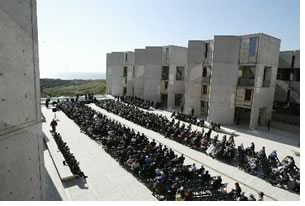

FROM
THE PRESIDENT’S OFFICE
Architecture: The Healing Art

by Thompson E. Penney, FAIA
For me, the highlight of this year’s convention in San Diego was the Investiture Ceremony. Sixty-two gifted men and women were welcomed as Fellows of The American Institute of Architects. The Investiture of new Fellows is always rich with symbolism. Never more so than this year.
The ceremony took place outdoors in La Jolla at the magnificent Salk Institute designed by AIA Gold Medal recipient Louis Kahn, FAIA. The complex is a monument to Dr. Jonas Salk, the remarkable physician who banished the scourge of polio. It is also a celebration of the transformational advances made by medical science in the 20th century.
As an architect, my thoughts naturally migrated from the purpose of the building to its design. Every architect knows the Salk Institute from the extensive writings and photo documentation of this extraordinary project. But pictures and words are a pale echo of the impact this building has on the eye and the spirit. You really have to be there to drink in the full measure of the design miracle that emerged out of the collaboration between the matched geniuses of Jonas Salk and Louis Kahn.
Everywhere I looked I was reminded not only of the meticulous craftsmanship and the brilliant marriage between the research facility and its site overlooking the Pacific to the west, but also of the power of architecture to enrich and elevate the human spirit. And, as my eyes searched out every detail, I began to wonder: Just as the work of dedicated physicians transformed the quality of life in the 20th century, might architects and design have a similar transformational impact in the 21st century? Not only do I think it’s possible, I believe that our profession may well be the leading light of this century in working toward a better world.
 The
mission of design
The
mission of design
I have come to realize that the great work of design is not the solitary
pursuit of novelty. It is the creative engagement with human needs. As
an architect, you have to care about people and care deeply. You have
to believe people matter. That means caring for the children and the teachers
in the classrooms we design; caring for the elderly and sick in our hospitals
and nursing homes; and caring for the janitors, the plumbers, and window
washers who maintain the physical fabric.
We have an opportunity—unique in my professional life—to reach out to make the connection in the public’s mind between their growing hunger for value and what we architects actually do. We have an opportunity not only to extol the poetry of our work—in other words, the art that elevates the human spirit—we have an opportunity, no, make that a responsibility to offer proof about how design enriches human life.
Design—the product and the process—is at the heart of how well we lead our lives and the choices we make; it is at the soul of how faithfully we carry out our role not to own the earth, but to be of it. Design is about discovery, integration, application, and the sharing of knowledge about the consequences of our work.
Such knowledge is called “predictive.” With it, we and our clients will be able to predict the effects of our decisions. With such knowledge we could design education into our schools, curing into our hospitals, and dignity into our low-income housing.
The Academy of Neurosciences for Architecture
We began our exploration of the premise “Design Matters!”
at the convention by celebrating, appropriately, what our hearts know
about design: the beauty, the exhilaration, the wonder. But we went on
to acknowledge the need to have the research tools to measure the “proof”
of design objectively, that is, the impact architecture has on our physical,
mental, and spiritual well being.
And it was at the convention that the AIA and AIA San Diego unveiled The Academy of Neurosciences for Architecture. The Academy will link neuroscience, one of the newest frontiers of knowledge, with architecture, one of the oldest disciplines of human civilization. It will study how people perceive the built environment and why they respond in the ways they do. With this information in hand, we will for the first time in our history have the data to prove that design truly matters.
In the 19th century, physicians were commonly regarded as little more than quacks. Chances were that despite the best intentions of their physicians, patients were likely to be worse for the experience. Knowledge gained from the application of the scientific method transformed the profession. The practice of medicine grew enormously in stature and influence. Indeed, physical health is today deemed a fundamental human right.
Within our lives, I see a similar transformation of our profession and a similar capacity to do good. Ours, after all, is not only the most public of the arts, it is also a healing art, an art that protects the life, safety, and welfare of the public. If what we design and build is a barometer of the health of our society, there is clearly much work to be done.
Copyright 2003 The American Institute of Architects.
All rights reserved. Home Page ![]()
![]()
 |
||
|
|
||